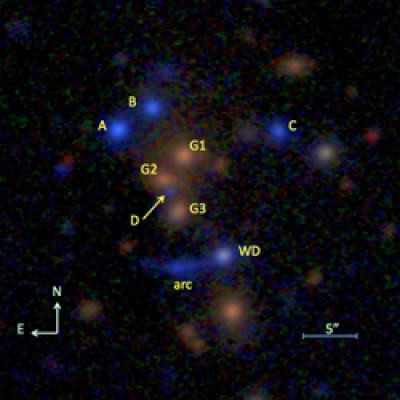Quasar, Powered By A Supermassive Black Hole, Observed In Six Light Reflections, The Most Ever By Astronomers
Students at the Niels Bohr Institute in Copenhagen were able to observe a quasar whose light had been reflected in six different images. For astronomers, the six reflections were the most views ever recorded of a quasar.

Anders Nielsen, Mikkel Kristensen, Mikkel Lindholmer and Thejs Brinckmann, students at the Niels Bohr Institute, were able to observe the quasar using the Nordic Optical Telescope, located at the Roque de los Muchachos Observatory, La Palma in the Canary Islands. The students’ research was published in the Astrophysical Journal.
A quasar, or quasi-stellar radio source, is an incredibly bright and active region surrounding a supermassive black hole at the center of a galaxy. According to the institute, the gravitational pull of quasars sucks in surrounding gas and debris. Due to the massive pull, gas and debris accelerate and soon travel at extremely fast speeds. The gas heats up, reaching temperatures in the millions of degrees, and emits radiation that heats up the surrounding cloud of dust and gas farther away from the black hole. The result is an incredibly bright burst of light which researchers can then observe.

Light does not travel in a straight line to Earth, and through a process called gravitational lensing, light can be reflected in different ways, thus creating different views. As light travels through the universe it encounters gravitational fields, be they from planets or stars, that bend the light and cause it to be redirected. Johan Fynbo, a professor at the Niels Bohr Institute and the students’ supervisor, said, “Instead of radiating in straight lines from the quasar, the light is deflected in an arc around the galaxy cluster. In this way, one can observe not just one, but several images of the same quasar. This is called the gravitational lens effect.” Fynbo says the light from the quasar has been traveling for 11 billion years.
According to the Danish researchers, within hours of using the NOT they were able to observe a quasar. Brinckmann said, “It was a new experience for us, but we could see immediately that it was a quasar. A typical characteristic of a quasar is that the light has broad emission lines from gas close to the black hole. We were very excited and moved on to the other ‘candidates’ from observation and later that night we found yet another light reflection of the quasar.”
The students were able to observe three light reflections of the quasar while astronomer Håkon Dahle, whose observations of the quasar were what inspired the students, discovered three more light reflections.
Fynbo notes “lensed” quasars typically have two or three reflections and the six reflections from this particular quasar are the most ever captured by astronomers. Based on the reflections, researchers can create a model of the light’s path across the universe, and measure the expansion of the universe as well as the mass of galaxy clusters encountered on the way to Earth.
© Copyright IBTimes 2024. All rights reserved.






















